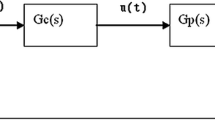Abstract
Classical and advanced hybridization methods are employed in the control literature to calibrate the tuning parameters of internal model control (IMC) and proportional-integral-derivative (PID) controllers. This paper presents an alternative tuning design for the generalized predictive controller (GPC) that is based on both the positional process model and cost function. The proposed method involves the selection of an integral polynomial weighting filter for reference and output signals to deal with reference tracking, disturbance rejection, model-plant mismatch (MPM), minimum control energy and closed-loop robustness. The filter positional GPC (FP-GPC) obtained is transformed into a two-degree-of-freedom polynomial filtered RST structure and then into filtered internal model control (F-IMC) and PID controllers. Also, a multi-objective optimization based on genetic algorithm is applied to tune the filter parameters. Numerical and experimental essays show the effectiveness of the proposed control methodology.







Similar content being viewed by others
References
Asano M, Yamamoto T (2001) A design of self-tuning predictive PID controllers. IEICE Trans Fundam E84–A:1779–1783
Beasley D, Bully DR, Martinz RR (1993a) An overview of genetic algorithms: Part 1. Fundam Univ Comput 15(2):58–69
Beasley D, Bully DR, Martinz RR (1993b) An overview of genetic algorithms: Part 2. Fundam Univ Comput 15(4):170–181
Braatz RD (1996) Internal model control. In: Levine WS (ed) The control handbook. CRC Press, Boca Raton, pp 215–224
Branke J, Deb K, Miettinen K, Sowinski R (2008) Multiobjective optimization: interactive and evolutionary approaches. Springer, London
Chien IL (1988) IMC-PID controller design—an extension. In Proceeding of the IFAC adaptive control chemical processes conference, pp 147–152
Clarke DW, Mohtadi C, Tuffs PS (1987) Generalized predictive control—Part I: the basic algorithm. Automatica 23:137–148
Clarke DW (1996) Adaptive predictive control. Annu Rev 20:83–94
Dai Z, Duan Y, Xu S, Shao K, Chen Q (2011) Adaptive PID controller based on generalized predictive control. In: Instrumentation, measurement, computer, communication and control, pp 993–995
de Araújo RB, Coelho AAR (2017) Filtered predictive control design using multi-objective optimization based on genetic algorithm for handling offset in chemical processes. Chem Eng Res Des 17:265–273
Fadali MS, Visioli A (2013) Digital control engineering: analysis and design, 2nd edn. Elsevier, New York
Garpinger O, Hagglund T, Astrom KJ (2014) Performance and robustness trade-offs in PID control. J Process Control 24:568–577
He W, Zhang H, Chen Z, Chu B, Cao K, Shan B, Chen R (2015) Generalized predictive control of temperature on an atomic layer deposition reactor. IEEE Trans Control Syst Technol 23:2408–2415
Jipuang Z, Ren S, Linan M, Mengxiao W (2002) Disturbance rejection performance of generalized predictive control. In: Proceedings of the 4th World congress on intelligent control and automation, pp 295–299
Katayama M, Yamamoto T (2004) Evolutional computation in designing a robust IMC-based PID controller. In: IEEE international conference on systems, man and cybernetics, pp 6120–6124
Landau ID (1998) The RST digital controller design and applications. Control Eng Pract 6:155–165
Morari M, Zafiriou E (1989) Robust process control. Prentice-Hall, Englewood Cliffs
Neshasteriz AR, Sedigh AK, Sadjadian H (2010) Generalized predictive control and tuning of industrial processes with second order plus dead time models. J Process Control 20:63–72
Preitl Z, Bars R, Vajk I, Haber R (2004) Internal model representation for generalized predictive control with constraint Handling. In: IEEE 4th international conference on intelligent systems design and application, pp 681–685
Sato T, Inoue A (2006) Improvement of tracking performance in self-tuning PID controller based on generalized predictive control. Int J Innov Comput Inf Control 2:491–503
Seborg DE, Mellichamp DA, Edgar TF, Doyle FJ (2011) Process dynamics and control. Wiley, New York
Silveira AS, Rodriguez JEN, Coelho AAR (2012) Robust design of a 2-DOF GMV controller: a direct self-tuning and fuzzy scheduling approach. ISA Trans 51:13–21
Skogestad S, Grimholt C (2012) Optimal PI-control and verification of the SIMC tuning rule. In: IFAC conference on advances in PID control, Brescia, Italy, pp 1–5
Skogestad S, Postlethwaite I (1996) Multivariable feedback control: analysis and design. Wiley, New York
Visioli A (2006) Practical PID control. Springer, London
Vuppu GKRP, Venkata SM, Kodati S (2015) Robust design of PID controller using IMC technique for integrating process based on maximum sensitivity. J Control Autom Electr Syst 26:466–470
Wang L, Rossiter JA (2008) Disturbance rejection and set-point tracking of sinusoidal signals using generalized predictive control. In: Proceedings of the 47th IEEE conference on decision and control, Cancun, Mexico, 9–11 Dec 2008, pp 4079–4084
Yamamoto T, Sato T, Inoue A (2006) Improvement of tracking performance in designing a GPC-based PID controller using a time-varying proportional gain. Trans Electr Electron Eng 1:438–441
Zhi-cheng Z, Zhi-yuan L, Jing-gang Z (2011) IMC-PID tuning method based on sensitivity specification for process with time-delay. J Central South Univ 18:1153–1160
Author information
Authors and Affiliations
Corresponding author
Additional information
Communicated by Jose Roberto Castilho Piqueira, Elbert E N Macau, Luiz de Siqueira Martins Filho.
Rights and permissions
About this article
Cite this article
Araújo, R.D.B., Coelho, A.A.R. Hybridization of IMC and PID control structures based on filtered GPC using genetic algorithm. Comp. Appl. Math. 37, 2152–2165 (2018). https://doi.org/10.1007/s40314-017-0444-y
Received:
Accepted:
Published:
Issue Date:
DOI: https://doi.org/10.1007/s40314-017-0444-y
Keywords
- Generalized predictive controller
- Internal model controller
- PID control
- Stability analysis
- Control accuracy
- Robustness analysis




